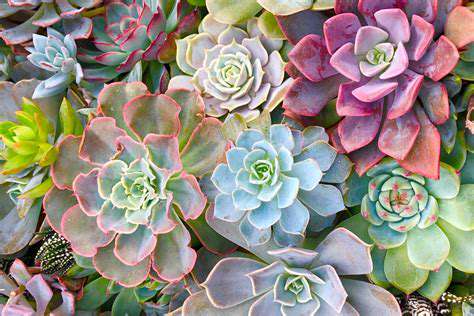Best Succulents for Beginners

Top 3 Beginner-Friendly Succulents
Easy-Care Echeveria
Echeverias, often called hens and chicks, are a fantastic choice for beginner succulent enthusiasts. Their rosette-shaped formations and vibrant colors are visually stunning, and their relatively low maintenance needs make them perfect for those just starting their succulent journey. They thrive in well-draining soil and bright, indirect light, and require infrequent watering, making them incredibly forgiving. Observing how the rosettes spread and multiply is a great way to witness the beauty of nature's slow growth.
These succulents come in a wide array of colors and shapes, from the classic emerald green to deep purples and even beautiful shades of pink and orange. The echeveria's resilience makes them perfect for a beginner's collection and is a great way to learn the basics of succulent care before moving on to more challenging varieties.
Charming Sedum
Sedums, often called stonecrops, are another superb option for novice succulent gardeners. They're known for their adaptability and ability to tolerate a wide range of conditions, including varying levels of sunlight and infrequent watering. The varied shapes and textures of their foliage, ranging from fleshy leaves to more upright growth patterns, contribute to their aesthetic appeal, making them a popular choice for gardens, containers, and even as indoor plants.
Sedums are incredibly low-maintenance, requiring minimal intervention to thrive. They're perfect for those who want the beauty of succulents without the constant worry of intricate care routines. Their drought tolerance and ability to withstand harsh conditions make them ideal for beginners learning the importance of proper drainage and well-suited soil compositions.
Robust Aloe
Aloes, with their distinctive spiky leaves and often striking colors, are a captivating addition to any collection. While they do require a bit more sunlight than some other succulents, their resilience and slow growth make them manageable for beginners. Caring for aloes involves understanding their need for well-draining soil and consistent, but not excessive, watering. It’s crucial to provide enough light to encourage their vibrant colors to shine.
Beyond their aesthetic appeal, some aloe species also have medicinal properties. Learning about the different types of aloe and their varied needs can be a rewarding experience for a beginner. This knowledge adds another layer of interest and appreciation for these unique plants, enriching the gardening experience.
Maintaining Your Succulent Collection

Watering Strategies for Success
Succulents are fascinating plants that thrive on infrequent watering, but understanding their specific needs is crucial for their health and longevity. Overwatering is a common culprit for succulent demise, leading to root rot and fungal issues. To avoid these problems, observe the soil's dryness before each watering. Stick your finger about an inch deep into the soil; if it feels dry, it's time to water thoroughly. Allow the excess water to drain completely from the pot to prevent waterlogging.
Different succulents have varying watering requirements based on their size, pot type, and environmental conditions. For example, smaller succulents in shallow pots may need watering more frequently than larger ones in deeper containers. Also, consider the time of year; during hot, dry spells, succulents will require more frequent watering than during cooler, wetter periods. Understanding these nuances will help you provide the best possible care for your collection.
Light Requirements and Positioning
Succulents are adapted to bright, sunny conditions, making them excellent choices for homes with ample natural light. Placing your succulents in a location that receives at least 6 hours of direct sunlight per day is ideal for optimal growth and vibrant coloration. However, avoid exposing them to harsh midday sun, which can lead to sunburn. A south-facing window is often a good choice, but you may need to rotate your plants periodically to ensure even exposure.
If your home doesn't have enough natural light, consider supplementing with grow lights. These lights can mimic natural sunlight and provide the necessary illumination for your succulents to thrive. Using grow lights effectively will allow you to cultivate a healthy and visually appealing succulent collection even in less sunny environments. Careful consideration of light levels is paramount for the overall health of your plants.
Soil Composition and Drainage
Well-draining soil is essential for the health of succulents. Poor drainage can lead to waterlogging, which can quickly damage the roots and potentially kill the plant. A soil mix specifically formulated for succulents or cacti is readily available at most garden centers and online retailers. These mixes typically contain a blend of perlite, pumice, and coarse sand to ensure excellent drainage.
Creating a suitable soil environment is crucial for the successful growth and health of your succulent collection. This will allow for proper aeration and water drainage, preventing root rot and promoting healthy root development. Using a soil mix that's too dense or retains too much water can lead to significant problems for your plants.
Pest and Disease Prevention
Succulents, like other plants, can be susceptible to pests and diseases. Regular inspection of your plants is vital to catch any issues early on. Look for signs of mealybugs, aphids, or spider mites, which can quickly infest a collection if left unchecked. Prompt action is essential when dealing with pests to prevent widespread damage. Use insecticidal soap or neem oil to control infestations. Proper hygiene, including cleaning tools and surfaces between plants, can greatly reduce the risk of pest spread.
Addressing potential diseases promptly is also important. If you notice any signs of fungal growth or other diseases, isolate the affected plant to prevent the spread. Seek advice from a local gardening expert or online resources to identify and treat the specific issue. Maintaining good hygiene and vigilance are crucial for preventing problems and ensuring the longevity of your succulent collection.











